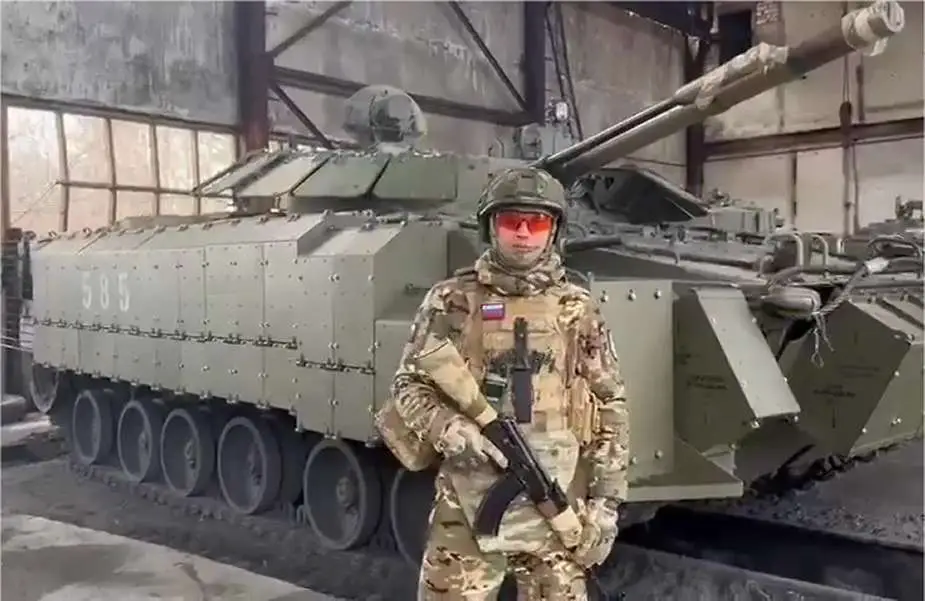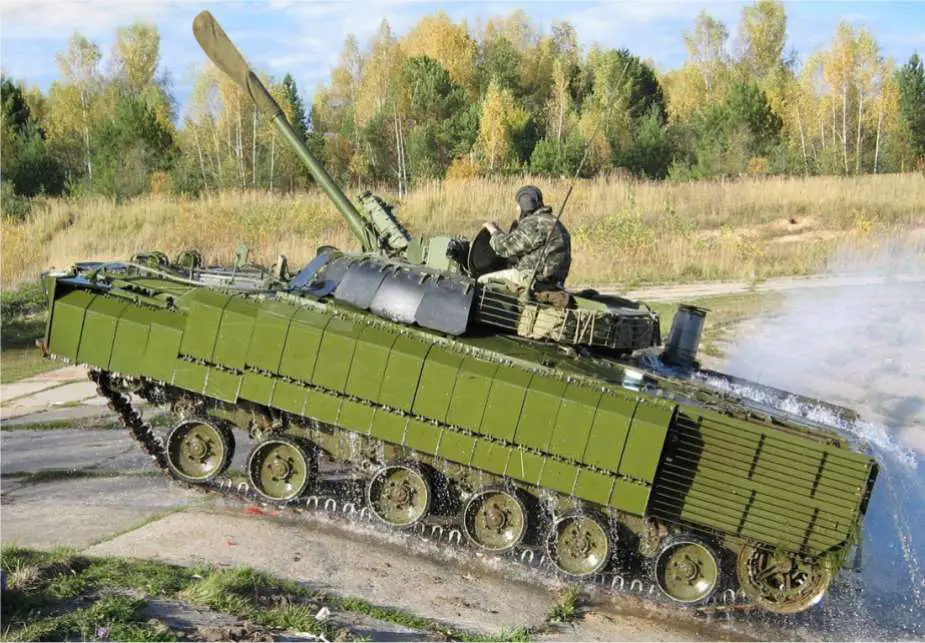- Army
- Conflicts in the world
- Israel - Iran conflict 2025
- Pakistan - India Conflict 2025
- Russia Ukraine War 2022
- Libya conflict day by day
- HAMAS - Israel War 2023
- Operation Serval in Mali French Army
- Sangaris operation Central African Republic
- Sangaris opération militaire République Centreafrique
- Ukraine - Russia conflict
- Syria conflict news
- Defence & Security Industry Technology
- Armies in the world
- Analysis Defense and Security Industry
- Conflicts in the world
- Navy
- Air
Russian Army deploys upgraded BMP-3 Cactus infantry fighting vehicle in Ukraine
On April 26, 2024, the Russian Forces in Ukraine received the first BMP-3 infantry fighting vehicle equipped with the 'Cactus' protection kit, which incorporates the 4S24, a new generation of Russian Explosive Reactive Armor (ERA). This deployment is part of a broader initiative where the Russian military is strengthening its operational capacity in Ukraine through increasing deliveries of BMP-3 vehicles, supplied by the Rostec state corporation.
Follow Army Recognition on Google News at this link

The video clearly shows that the protection kit has been further strengthened, with the addition of new 4S24 elements and armor plates on the turret. (Picture source: Russian social media)
As reported by Army Recognition on April 11, 2024, the Russian military augmented its forces in Ukraine with a new batch of BMP-3 infantry fighting vehicles (IFVs), supplied by the Rostec state corporation through its Kurganmashzavod subsidiary. This delivery is part of an ongoing initiative to support Russian military operations in Ukraine by updating and reinforcing their armored vehicle capabilities. Additionally, Rostec is planning to supply the 2S38 Derivatsiya-PVO, an anti-drone artillery system, to further diversify the tactical resources available to Russian forces in the conflict zone.
The BMP-3, developed as a successor to the BMP-1 and BMP-2 infantry fighting vehicles, entered service with the Soviet Army in 1990. This model was designed to engage both ground and aerial targets in various conditions, including while stationary, on the move, or afloat, representing an evolution in the BMP vehicle series. The vehicle's chassis is manufactured by Kurganmashzavod and the turret system by the Instrument Design Bureau (KBP) of Tula. The BMP-3 has also been exported; notably, Abu Dhabi in the United Arab Emirates acquired 330 units with modifications such as thermal sights for improved targeting, with deliveries from 1992 to 1995. In 2015, Iraq placed an order for 300 units, indicating sustained international interest in this model.
The BMP-3 is equipped with multiple weapons, including a primary 100mm 2A70 semi-automatic rifled gun/missile launcher capable of firing both conventional rounds and guided missiles. This is supplemented by a 30mm 2A72 coaxial cannon and a 7.62mm PKT coaxial machine gun, enabling the vehicle to engage a variety of targets, including tanks and slow-moving aerial targets like helicopters. The vehicle includes an automatic fire control system that allows for target engagement at distances up to 4,000 meters, featuring manual and automatic modes to enhance operational flexibility in combat situations.
For protection and mobility, the BMP-3 is built with a hull and turret constructed from welded aluminum, which provides resistance against small arms fire and shell fragments. It includes spaced armor as a standard feature, with the option to add explosive reactive armor for additional protection. The BMP-3 is driven by a V-shaped UTD-29 diesel engine, allowing it to reach speeds of up to 70 km/h on land and 10 km/h in water. Its amphibious capabilities are supported by a hydropneumatic suspension system that can adjust the vehicle's ground clearance. The BMP-3 has been adapted into various versions such as the BMP-3M, BMP-3K, and BMP-3F, designed for specific military functions, reflecting its adaptability to different operational requirements.

During its development phase, the 'Cactus' protection kit provided defense coverage for a significantly smaller portion of the BMP-3. (Picture source: Russian social media)
Previously known as 'Karkas' or 'Karkas-2', the 'Cactus' package, designed for the BMP-3, integrates the 4S24 Explosive Reactive Armor (ERA) to cover 62% of the vehicle's side hull, 36% of the front hull, and 70% of the turret at the time of its unveiling. Additionally, grid screens are deployed to protect the rear of the turret near the Motor Transmission Unit (MTO), while the total weight increase for the vehicle is 4,200 kg. However, from the video, it is clear that this percentage has been exceeded, with the addition of new 4S24 elements and armor plates on the turret.
Beyond its primary function against cumulative charges, the 'Cactus' package also provides resistance against armor-piercing bullets B-32, 23-mm BZT projectiles, and 30-mm armor-piercing shells. The design of the 4S24 elements includes a specific formulation of explosives that prevents detonation from impacts such as BZT bullets, projectiles up to 30 mm, large-caliber high-explosive shell fragments, and various incendiary mixtures, including napalm.
The 4S24 is a type of Russian explosive reactive armor (ERA) engineered to enhance the defensive capabilities of Russian armored vehicles against anti-tank weapons, particularly those utilizing shaped charges. Developed to address the evolving challenges of modern warfare, where the threat from anti-tank guided missiles (ATGMs) and rocket-propelled grenades (RPGs) is significant, the 4S24 is recognized for its safety enhancements, reduced collateral damage, and effective protective measures compared to older models such as the 4S20 from the "Kontakt" series.
Comprising a composite material incorporating explosives, metallic plates, and a polymeric matrix, the 4S24 is engineered for controlled detonation, ensuring the neutralization of incoming threats without compromising the vehicle's integrity. Each module is specifically engineered to fit within the rectangular panels of Russian ERA systems, with dimensions of 251.9 mm in length, 131.9 mm in width, and 13 mm in height. Weighing approximately 1.36 kg per element, the 4S24 achieves a balance between effectiveness and minimal impact on vehicle mobility, which is crucial for maintaining the mobility of the armored vehicle. Moreover, the 4S24 can operate effectively across a wide temperature range, from -50 to +55 degrees Celsius, ensuring reliability under varied environmental conditions.
The primary function of the 4S24 is to disrupt the jet formed by a shaped charge, such as those from rocket-propelled grenades and anti-tank missiles. Upon impact, the ERA detonates in a manner that projects its metallic plates outward at strategic angles, disrupting the penetration capability of shaped charges and reducing their effectiveness. The 4S24 elements are strategically placed on the vehicle's exterior in areas most likely to face direct hits, such as the front, sides, and sometimes the turret, with angles optimized to disrupt penetrating jets effectively.
The integration of safety features into the 4S24 further enhances its appeal. Unlike traditional ERA systems, which pose risks of collateral damage to nearby infantry due to outward explosions of shrapnel, the 4S24 mitigates this risk by containing most of the detonation impact within specially designed casings, directing the force outward away from the vehicle. Additionally, the design incorporates features to prevent accidental detonations from non-threat impacts, such as small arms fire or shrapnel, common in combat environments.
In combat scenarios, its adaptability allows for its use in both new vehicle designs and retrofitting older models, making it a cost-effective solution for upgrading existing fleets, as seen with the T-72B3 Obr. 2016 and the T-80BVM tanks. Moreover, the 4S24 can be easily integrated with other defensive systems like composite armor and active protection systems (APS), creating a multi-layered defense mechanism that enhances overall vehicle protection significantly.


























